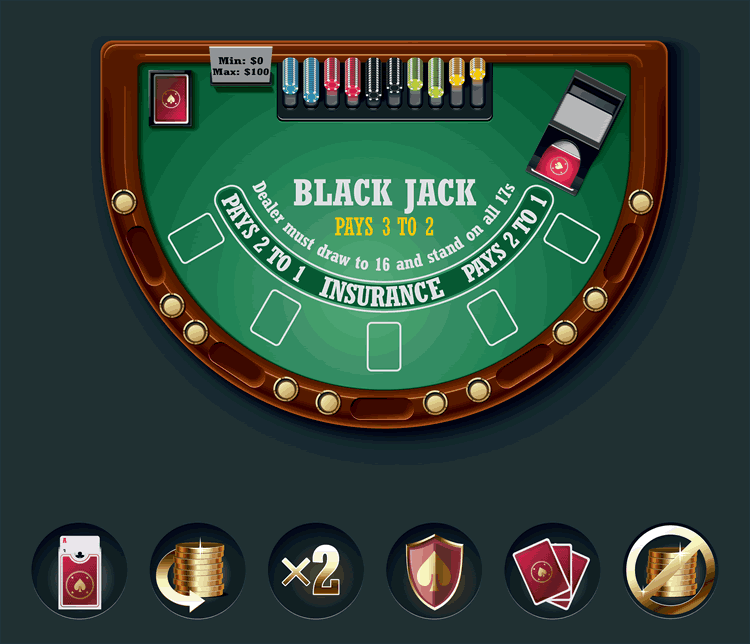Top 10 Tips For Winning Online Blackjack

The most popular table game in the casino.
Blackjack, one of the simplest casino games you’ll find online, is a perennial favorite among gamblers. Folks with little experience like it because it’s easy to learn. Veteran gamblers like it because it poses a low house edge. If you stick to using basic blackjack strategy, you stand a good chance of increasing your bankroll – at least, in the short term.
Having said that, people routinely lose money on blackjack because they’re unfamiliar with basic strategy. They make inconsistent and ill-advised decisions regarding whether to “hit,” “stand,” “double” and “split.”
Consequently, they lose hands they would otherwise win if only they followed a proven game plan.
You’ll find our top 10 tips for winning at blackjack below. What follows isn’t meant to be a complete tutorial on blackjack strategy. Instead, we’ll cover the 10 most important things to keep in mind if you want to maximize your chances of walking away with a profit.
My Top Blackjack Casinos
- Bovada Casino - Our #1 pick. Offers single deck online blackjack.
- Slots.LV - If you like blackjack and slots then this is the site for you.
- BetOnline Casino - Live dealer casino. Watch real dealers deal blackjack via webcam.
#1 – Assume The Dealer Is Hiding A “10”
You’ve probably heard this advice before.
The dealer receives two cards, one that faces up and one that faces down. The downcard has a huge influence on whether you win or lose the hand. The problem, of course, is that you don’t know the face value of that card. So there’s no way to know for certain whether you should hit or stand.
But you can make reasonable assumptions.
In a single deck, there are 16 cards that have a face value of 10 (four 10s, four Jacks, four Queens and four Kings). That’s over 30% of the deck. Given that, it’s reasonable to assume the dealer’s downcard is one of those 16 cards.
For example, if the dealer’s upcard is a 7, you should assume his hand has a value of 17. If the upcard is a 4, assume his hand has a value of 14.
That hypothesis allows you to decide whether you should hit or stand based on your chances of beating the dealer’s hand.
#2 – Watch For Dealer “Bust Cards”
Bust cards are dealer upcards that increase the likelihood that the dealer will bust. Keep your eyes open for the following:
– 2s
– 3s
– 4s
– 5s
– 6s
When the dealer shows any of the above cards, he’ll need to hit. As we noted above, we can safely assume his downcard has a face value of 10. Given that 10s and face cards make up 30% of the deck, we can also assume there’s a fair chance he’ll draw a 10. That will cause him to bust.
Here’s an example: let’s say the dealer is showing a 6 and has a 10 in the hole (i.e. his downcard). He’s forced to hit. Let’s say he draws a face card. That would give him 26, busting his hand.
When the dealer shows a bust card, basic blackjack strategy specifies that you should stand. The exception is when the dealer shows a 2 or 3 and you’re holding a 12. In that case, hit.
#3 – Memorize When To Double Down
Doubling down at the right times is one of the keys to minimizing the house edge on blackjack. The problem is, few people know exactly when to double down. When they do it, it’s part of a general, “broad stroke” strategy. For example, they always double down on a 10 or 11.
Unfortunately, that leaves them open to a lot of risky circumstances.
Here’s a quick summary of when you should double down on your bets…
– If you’re holding an 11, double unless the dealer’s upcard is an Ace.
– If you’re holding a 10, double unless the dealer’s upcard is an Ace or 10 (or face card).
– If you’re holding a 9, double if the dealer’s upcard is a 3 through 6.
– If you’re holding an soft 17 (Ace/6) or soft 18 (Ace/7), double if the dealer’s upcard is a 3 through 6.
– If you’re holding an soft 15 or soft 16, double if the dealer’s upcard is a 4 through 6.
– If you’re holding an soft 13 or soft 14, double if the dealer’s upcard is a 5 or 6.
– If you’re holding a pair of 5s, double unless the dealer’s upcard is an Ace or 10 (or face card).
Memorize the above situations. Or better yet, have a “hand chart” next to you while you play.
#4 – Hit On A Soft 17, Stand On A Hard 17
You should always stand on a hard 17. The chances of busting on a draw are too great. The problem is, there’s a good chance you’ll lose the hand unless the dealer is showing a bust card.
In other words, a hard 17 is a terrible hand because the odds of winning are slim and you don’t have many options.
A soft 17 (Ace/6) gives you options. Because a 17 is unlikely to help you win the hand, it’s in your interest to hit. In fact, as we covered above, you should double down if the dealer is showing a 3 through 6.
#5 – Learn The “Rule Of 9”
The Rule of 9 helps you to determine when to double down on a soft hand (a hand that carries an Ace). We covered the basic rules of doubling soft hands above. But it’s a lot to remember.
Fortunately, there’s a simpler way. Here’s how to do it:
Add the face value of the dealer’s upcard to the face value of the non-Ace card in your hand. If the combined total is nine or greater, double down. If the total is less than nine, don’t double down.
For example, suppose the dealer’s upcard is a 5 and your non-Ace card is a 6. Adding the two cards results in 11, which means you should double down.
Suppose the dealer’s upcard is a 3 and your non-Ace card is a 4. In this case, you shouldn’t double down because the combined total is less than nine.
#6 – Don’t Take Insurance
When the dealer shows an Ace, you’ll be given a chance to buy insurance. This feature allows you to make a second wager, typically half the amount of your original wager, on the possibility that the dealer has blackjack.
If the dealer does indeed have blackjack, you’ll be paid even money on the insurance bet and lose your original bet. In effect, this allows you to mitigate your potential loss by returning half of your money.
Here’s an example:
Suppose you bet $10 and the dealer’s upcard is an Ace. You decide to bet $5 for insurance. Let’s say the dealer has blackjack. You’ll lose your original $10 bet, but receive 2 to 1 (or $5) on your insurance bet. In other words, you’ll receive back half of your initial wager.
A lot of people think insurance is a good deal. So they invariably opt for it whenever it’s offered. In reality, this is a terrible blackjack bet. While there’s a fairly good chance the dealer will have blackjack, the odds aren’t good enough to warrant immediate surrender of half your bet.
Over the long run, it’s better to forgo insurance and take your chances.
#7 – Always Split Aces And Eights
This is one of the clearest-cut rules in blackjack. If you’re dealt a pair of Aces or eights, split them.
Here’s the reasoning:
A pair of 8s gives you 16. That’s a terrible hand. Splitting the 8s gives you a chance to draw 10s. That will give you 18 for each hand, which puts you in a much better position.
A pair of Aces gives you either 2 or a soft 12. That too is a terrible hand. Splitting the Aces gives you a chance to draw two blackjacks.
There are no exceptions to this rule. If you’re dealt two Aces or two 8s, split them.
#8 – Never Split 5s and 10s
This is another clear-cut rule. In the same way that you should always split Aces and 8s, you should never split 5s and 10s.
A pair of 5s is a great hand because there’s a high likelihood you’ll draw a 10. Doing so will give your hand a value of 20, which puts you in a good position to win your bet. Splitting the 5s risks drawing 10s to each one, leaving you with two hands with a value of 15.
A pair of 10s puts you in position to win your bet without your having to do any work. You don’t even need to hit to have a good chance of winning.
Always keep pairs of 5s and 10s together.
#9 – Learn When To Split Other Pairs
Knowing when to split other pairs is more complicated. Much depends on the dealer’s upcard. Here’s a brief rundown of when to split certain pairs.
2s and 3s – split when the dealer is showing a 2 through 7
4s – split when the dealer is showing a 5 or 6
6s – split when the dealer is showing a 2 through 6
7s – split when the dealer is showing a 2 through 7
9s – split when the dealer is showing a 2 through 6, or an 8 or 9
Admittedly, the above circumstances are difficult to remember unless you’re an experienced player. That’s the reason it’s a good idea to keep a hand chart next to you. There’s no shame in referring to it when necessary. In fact, since you’re playing online, no one has to know.
#10 – Play With The Right Expectations
Blackjack gives the house a razor-thin edge. But the house’s edge is always there, working against you. That means you can expect to lose money over the long run. Even if you play perfectly, using the tips outlined above, the long-term odds are not in your favor.
This is a casino game, after all.
Having said that, you’ll enjoy winning streaks in blackjack. Enjoy them when they come. But sock away some of your winnings to subsidize your playing when the cards move against you. Losing streaks are just as common as winning streaks.
Remember, the house always wins in the end.
If you’re looking for a place to play blackjack for free, I highly recommend checking out Bovada Casino and Slots.lv. I’ve put both gambling websites through their paces (read my Bovada Casino review and Slots.lv and tested every aspect of their respective playing environments. I’ve also verified that both sites are trustworthy and responsive when it comes to withdrawing your winnings.
Find out today why thousands of other online casino fans play at Bovada and Slots lv and the new BTC casino, Ignition!
- Bovada Casino - Our #1 pick. Offers single deck online blackjack.
- Slots.LV - If you like blackjack and slots then this is the site for you.
- BetOnline Casino - Live dealer casino. Watch real dealers deal blackjack via webcam.
More Great Content





